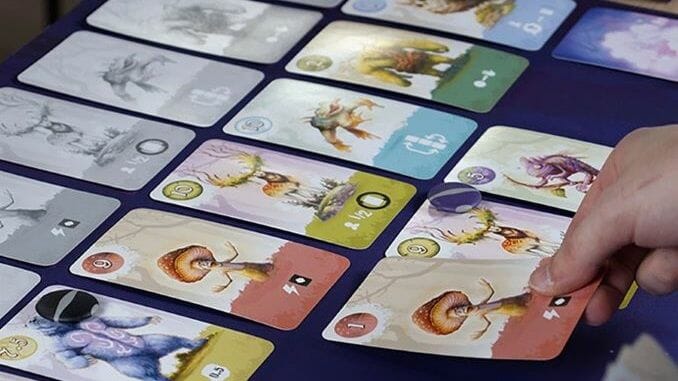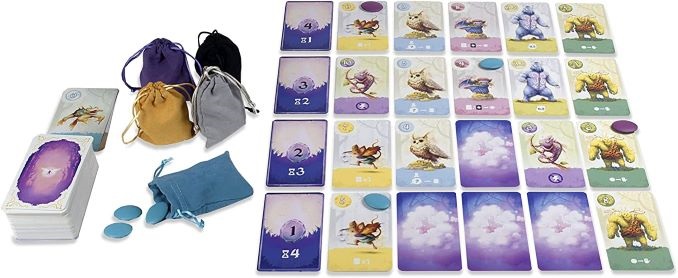On a player’s turn, they may first choose to place a bet in the current round (row) on the table, by placing a pebble either on a card that’s already been played or an open space. In the first round, players may also place a secret bet on a creature, taking a card from their hands, placing it face down on the table, and placing the pebble on it. If a creature on which you’ve bet is one of the winning creatures that survives to the end of the fifth round, you get the Prestige Points for the row where you placed your pebble, from 4 points for the first row to 1 point for the fourth, or 5 points for your secret bid. You may, on a later turn, choose to reveal your secret bid, which may give you Control of that column, giving you access to its power. Once placed, a pebble remains there for the rest of the game.
After placing a bid or declining to do so, the player must play a card. Creatures go in their respective columns, and you may play a card on top of an existing card. Only the topmost card matters when all spaces in the row are filled; if one creature has the lowest value, it is eliminated from the tournament, and the remainder of its column is filled in with placeholder cards. Thus there’s quite a bit of strategy involved in what to play, and when: You might play a 0 card to a creature on which your opponents have bet to try to eliminate it, or a 9 or a 10 to one where you’ve bet, or should you save the higher numbers until later in the game? I’ve played this and ended up with a 10 in my hand for the creature on which I’d bet in the first round, which is as strong a case of Board Game Regret as I have encountered.
If you play a card where you have Control, by placing the most valuable bets on that creature so far, then you can activate its power. Each card has a unique power. One allows you to draw three new cards from the deck; one lets you retrieve a pebble you’ve already placed (the only way this can happen); several let you take up cards already played to the table. They’re all powerful, and you get few chances to use them—which all the more encourages your opponents to try to undercut you and get your favored creatures out of the game. Chameleon cards function as wild cards and can go in any column, but when you play one, you can’t use the creature’s power even if you have control.
Equinox has a lovely way of accelerating as you go; because each round is shorter by one creature, and because you have more pebbles out on the tableau, it takes fewer cards to complete each subsequent round, and players have a better idea of what they want or need to do. The take-that aspect of the card-playing is easy to grasp, even for younger players, but is just as satisfying for adults. It plays two to five players, although it’s best with at least three, and games take about 40-45 minutes. Colossal Arena has a cult following, for good reason, but the art in Equinox is far more appealing, especially to kids, and the game just looks better on the table. It also offers two additional creatures and some small changes to the powers of existing creatures. We’ve found it a big hit even with our eight-year-old, who grasped game play right away but needed a little coaxing on strategy. It’s always good to see an old out-of-print game come back with a fresh coat of paint.
Keith Law is the author of The Inside Game and Smart Baseball and a senior baseball writer for The Athletic. You can find his personal blog the dish, covering games, literature, and more, at meadowparty.com/blog.

